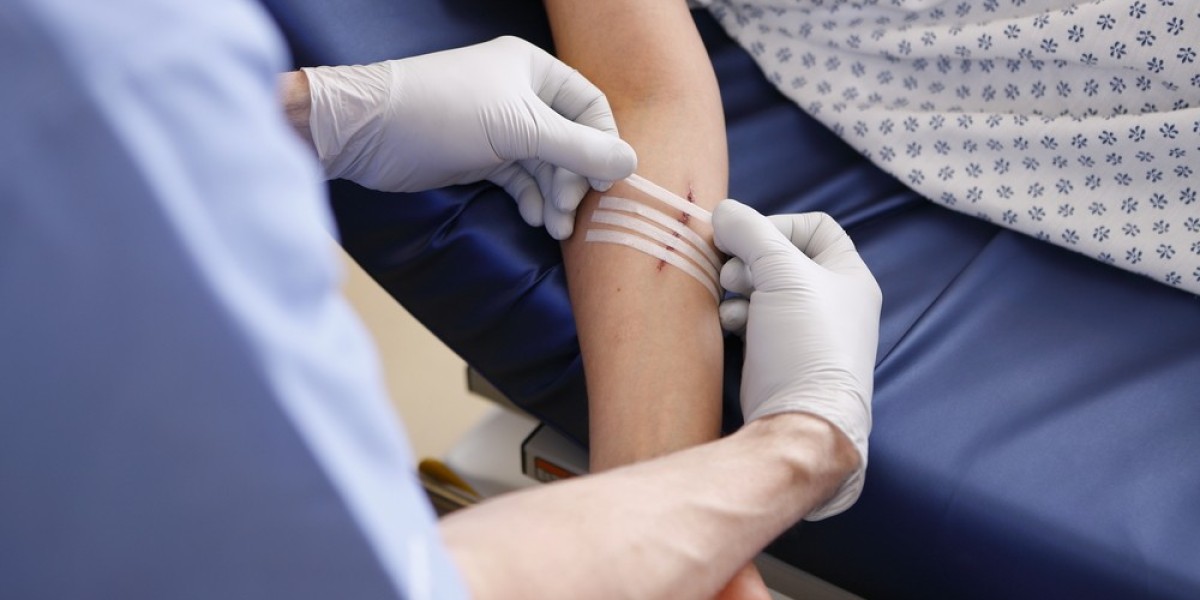Why Remove Running Sutures?
Before we dive into the removal process, it's important to understand how to remove a running sutures is necessary. While sutures are essential for holding the wound edges together during the initial stages of healing, they can hinder the healing process if left in for too long.
Leaving sutures in place beyond the required time can lead to complications such as scarring, infection, and tissue damage. Therefore, timely removal is crucial to ensure proper wound healing.
Tools You'll Need
Before you start, make sure you have the following items ready:
Sterile Scissors: To cut the suture thread.
Adson Forceps: To hold and manipulate the suture for easy removal.
Sterile Gloves: To maintain aseptic conditions.
Sterile Gauze Pads and Antiseptic Solution: To clean the area around the suture.
A Well-Lit, Clean Area: Proper lighting and cleanliness are essential for a successful removal procedure.
Step-by-Step Guide to Removing Running Sutures
Step 1: Preparation
Start by ensuring you are in a clean and well-lit area. Wash your hands thoroughly and put on sterile gloves to maintain aseptic conditions. If the patient is assisting in the removal, instruct them to clean their hands as well.
Step 2: Patient Positioning
Position the patient comfortably, ensuring that the area with the running suture is easily accessible. For example, if you're removing sutures from a wound on the arm, the patient's arm should be extended and comfortably supported.
Step 3: Clean the Area
Using sterile gauze pads and an antiseptic solution, clean the area around the suture. This prevents any bacteria on the skin's surface from entering the wound during suture removal.
Step 4: Locate the Knot
Inspect the running suture closely, and you'll notice that there's a knot at one end. This is where you'll begin the removal process.
Step 5: Cut the Knot
With sterile scissors, carefully cut the knot. Be sure not to pull or tug at the suture while cutting, as this can cause discomfort to the patient. Once the knot is cut, you'll have two loose ends of the suture.
Step 6: Remove the Suture
Using Adson forceps, gently grasp one of the loose suture ends. Hold the forceps close to the patient's skin to ensure precise control. Gradually pull the suture through the skin and tissue in the same direction in which it was initially inserted.
Step 7: Continue Removing the Suture
Continue to grasp the suture with the forceps and pull it through, following the path it takes under the skin. The key to painless suture removal is to pull the suture smoothly and steadily, avoiding any sudden or jerky movements.
Step 8: Inspect the Wound
Once you've removed the entire suture, carefully inspect the wound. Ensure that the wound edges are well-approximated, meaning they are still touching and in good alignment. If you notice any signs of infection or wound dehiscence (wound edges pulling apart), it's essential to seek medical attention promptly.
Step 9: Repeat as Needed
If multiple running sutures were used to close the wound, repeat the above steps for each suture.
Aftercare and Important Tips
After removing the running sutures, it's crucial to provide proper aftercare to ensure the wound continues to heal effectively.
Keep the Wound Clean: Advise the patient to keep the wound clean and dry. Use an antiseptic ointment if recommended by the healthcare provider.
Avoid Excessive Moisture: Excessive moisture can slow down the healing process. Encourage the patient to avoid activities like swimming or soaking in hot tubs until the wound is fully healed.
Protect from Sun Exposure: Direct sunlight can cause scarring. Recommend protecting the wound from the sun or applying sunscreen over the healed wound.
Watch for Signs of Infection: Educate the patient about the signs of infection, such as increased redness, swelling, discharge, or fever. Instruct them to seek medical attention if these symptoms occur.
Follow-Up with Healthcare Provider: Ensure the patient follows up with their healthcare provider as advised to monitor the wound's progress.
Post-Suture Removal Care: Ensuring Optimal Wound Healing
Suture removal marks a significant milestone in the healing process of wounds or incisions. While the procedure itself is relatively straightforward, what follows is equally essential for the patient's overall recovery.
In this article, we will explore the critical post-suture removal care measures that patients and caregivers should be aware of to ensure optimal wound healing.
Maintain Wound Hygiene
After suture removal, it is paramount to maintain proper wound hygiene. The wound should be kept clean and dry to prevent infection. Patients should be instructed to gently cleanse the wound area with mild soap and water, ensuring they pat it dry with a clean, sterile gauze or soft cloth. Encourage them to avoid harsh rubbing, as it may irritate the wound.
Keep the Wound Covered
While the wound is healing, it's beneficial to keep it covered with a sterile bandage or dressing. This provides an extra layer of protection against external contaminants and friction, which could cause irritation or complications. Patients should change the bandage regularly, as per their healthcare provider's instructions.
Minimise Moisture Exposure
Excessive moisture can hinder the wound-healing process and may lead to complications. It is advisable to instruct patients to avoid activities that can expose the wound to prolonged moisture, such as swimming or soaking in hot tubs. Patients should also be aware of their bathing habits and use waterproof dressings if necessary to prevent wound saturation.
Protect from Sun Exposure
Direct sunlight can be detrimental to healing wounds, causing pigmentation changes and potential scarring. Patients should be advised to protect the healed wound from sun exposure. This can be achieved by keeping the wound covered with clothing or applying a broad-spectrum sunscreen over the area.
Be Aware of Signs of Infection
Educating patients about the signs of infection is essential. These signs may include increased redness, swelling, warmth around the wound, discharge (especially if it becomes pus-like), or a fever. Patients should be informed that if any of these symptoms occur, they must seek immediate medical attention.
Prevent Excessive Movement and Trauma
Encourage patients to avoid excessive movement or activities that could traumatise the wound area. Such activities could lead to complications or delayed healing. It's crucial to instruct them to handle the area gently and refrain from picking at any scabs that may form.
Ensure Proper Nutrition
A well-balanced diet is crucial for wound healing. Proper nutrition provides the body with the essential nutrients required for tissue repair and regeneration. Encourage patients to maintain a diet rich in vitamins, minerals, and protein, as these are essential for the healing process.
Follow Up with the Healthcare Provider
Patients should adhere to their healthcare provider's follow-up schedule. This allows the provider to monitor the wound's progress and address any concerns promptly. If a patient has any questions or uncertainties about their wound's healing, they should not hesitate to contact their healthcare provider for guidance.
Manage Pain and Discomfort
It is common to experience some level of discomfort after suture removal. Patients may be advised to take over-the-counter pain relievers or prescribed medications to manage any pain or discomfort. They must follow the healthcare provider's recommendations regarding pain management.
Emphasise Scar Care
As the wound heals, it's common for a scar to form. To minimise scarring and promote optimal aesthetic outcomes, patients should be informed about scar care techniques. Silicone gels or sheets, massaging the scar tissue, and keeping the area moisturised can all contribute to reducing the appearance of scars.
Conclusion
Removing running sutures is a simple yet crucial step in the wound-healing process. While a healthcare professional can perform the procedure, patients can also be educated and trained to perform it themselves under guidance.
By following the step-by-step guide provided here and ensuring proper aftercare, you can contribute to a smooth and successful recovery, ultimately leading to minimal scarring and optimal wound healing.
If you have any concerns or experience any issues during or after suture removal, do not hesitate to consult with a healthcare provider for guidance and assistance.
 " class="wow_main_float_head_img">
" class="wow_main_float_head_img">







